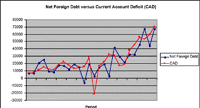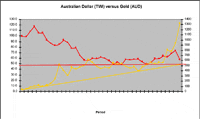|
|||
Are the fundamentals for gold poor?Troy Schwensen There have been some negative views expressed of late regarding the fundamentals for gold. The GFMS group executive chairman Philip Klapwijk recently presented at the New York Hard Assets convention. He highlighted falling fabrication demand and increasing levels of scrap sales as the key underlying factors for poor supply and demand fundamentals. He made the point that the current supply/demand balance shouldn't even support the present gold price. Today I would like to refer you to a very informative article written by Paul Van Eeden back in August 1998, aptly called: Understanding the Gold Price. This article makes some very pertinent points which I will share with you here in summary:
Van Eeden next turned to analyzing exchange rate influence. He deemed the stronger US dollar in the late 90's was the major driving force behind weaker US dollar gold prices. The point was made that gold in other currencies, such as the Japanese yen and Swiss franc during the late 90's, declined by only half the levels of the US dollar gold price. He suggests that perhaps this half could be a function of the central bank gold sales, producer forward selling, private sales etc. The remainder was more a function of currency movements. If you agree that gold is money, then making this important connection between exchange rate movements and the price of gold is not that greater leap of faith. To determine the true fundamentals for gold you then really need to focus more on the fundamentals of the currency in question. Two key indicators for this are the Current Account position and Net Foreign debt levels. Generally speaking, the higher these two levels are relative to the size of the economy and other countries, the riskier the respective currency is deemed to be. Being an Australian and having gold investments in companies with domestic operations, this becomes a very important factor. Looking at the trend of Australia's annual current account deficits and the consequential increase in net foreign debt levels, one can very quickly appreciate why the Australian dollar is considered risky. It also explains why Australia's interest rate levels are generally so much higher than other western countries.  A look at the next chart clearly demonstrates the ill effects of this trend on the Australian dollar over time. The gold price in Australian dollars is charted along side to demonstrate the protection it offers investors against this risk. As the global economy continues to slow and risk aversion increases, the probability of the Australian dollar breaking long term support at just under 50 on a Trade Weighted basis (TWI) looks increasingly likely. Unless interest rates rise to a level which fairly compensates international investors for risk, a potential currency crises looms large. With the bulk of what Australians consume coming from overseas, the risk of higher inflation levels is increasing. The recent spike we have seen in the domestic gold price highlights this risk.  So in conclusion, when you read about the poor fundamentals for gold from various sources ask yourself this. Is the analyst in question looking at gold as a currency or simply as a commodity? A failure to acknowledge gold's monetary role is short sighted and invariably leads to inaccurate not to mention non-committal forecasts. This generally leaves investors confused and frustrated. It must be said that similar supply and demand fundamentals were present throughout the 1970's as the gold price rose. The above chart would suggest that they were as irrelevant then as they are today. The trend in respective currencies appears to provide a much more accurate assessment. For anyone interested, I write a free monthly newsletter on the precious metals markets. This includes technical analysis as well as company updates on many of the prominent precious metals companies from around the world. Past articles and newsletters can be accessed in the archive section. Pay us a visit at the website below. Troy Schwensen CPA Troy Schwensen
is a full time investor/Trader who spent 8 years in the Accounting
and Finance industry which included roles with blue chip Australian
companies such as Goodman Fielder and Fosters where he spent three
years as a Senior Business Analyst. He made a decision to leave
this industry in 2002 after discovering a long term opportunity
to invest and trade in the precious metals market where he has
since used his analytical skills to build a sound working knowledge
of the sector and its comprising companies. |
